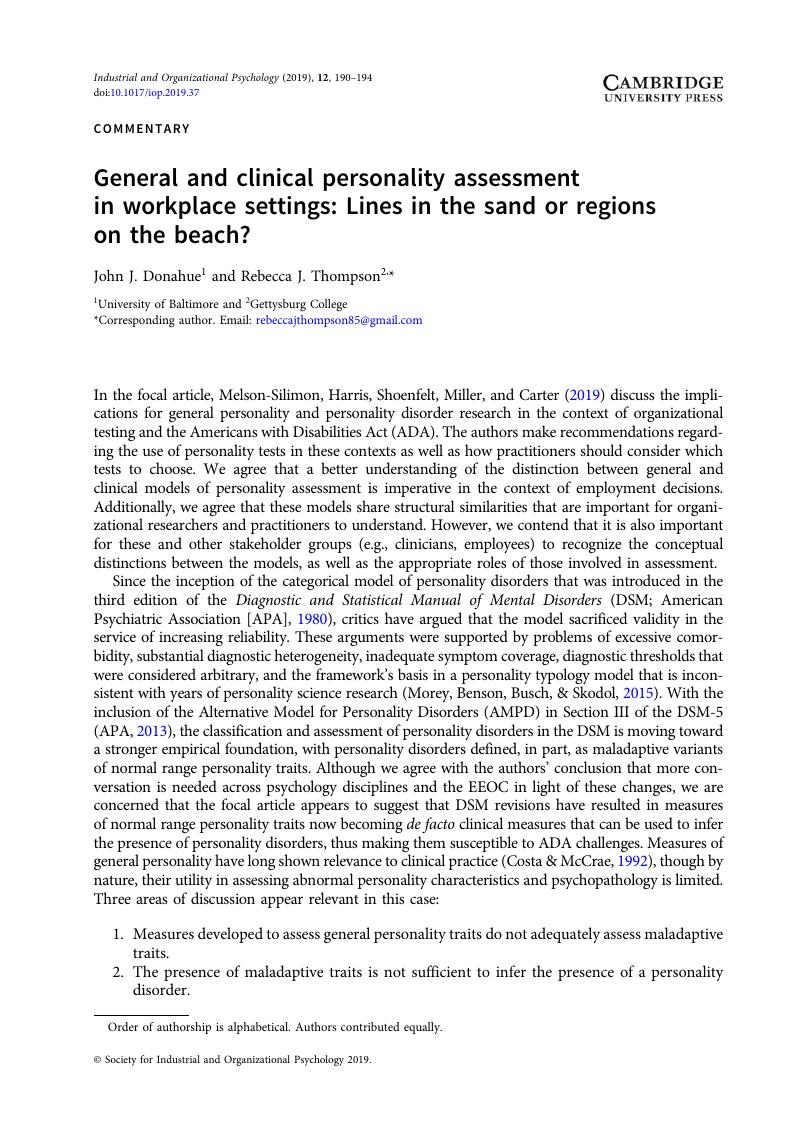No CrossRef data available.
Article contents
General and clinical personality assessment in workplace settings: Lines in the sand or regions on the beach?
Published online by Cambridge University Press: 01 August 2019
Abstract
An abstract is not available for this content so a preview has been provided. Please use the Get access link above for information on how to access this content.

- Type
- Commentaries
- Information
- Copyright
- © Society for Industrial and Organizational Psychology 2019
Footnotes
Order of authorship is alphabetical. Authors contributed equally.
References
American Psychiatric Association. (1980). Diagnostic and statistical manual of mental disorders (3rd ed.). Washington, DC: Author.Google Scholar
American Psychiatric Association. (2013). Diagnostic and statistical manual of mental disorders (5th ed.). Washington, DC: Author.Google Scholar
Barrick, M. R., & Mount, M. K. (1991). The big five personality dimensions and job performance: A meta-analysis. Personnel Psychology, 44(1), 1–26.CrossRefGoogle Scholar
Barrick, M. R., Mount, M. K., & Judge, T. A. (2001). Personality and performance at the beginning of the new millennium: What do we know and where do we go next? International Journal of Selection and Assessment, 9(1–2), 9–30.CrossRefGoogle Scholar
Barrick, M. R., Stewart, G. L., Neubert, M. J., & Mount, M. K. (1998). Relating member ability and personality to work-team processes and team effectiveness. Journal of Applied Psychology, 83(3), 377–391.CrossRefGoogle Scholar
Costa, P. T., & McCrae, R. R. (1992). Normal personality assessment in clinical practice: The NEO Personality Inventory. Psychological Assessment, 4(1), 5–13.CrossRefGoogle Scholar
Dilchert, S., Ones, D. S., & Krueger, R. F. (2014). Maladaptive personality constructs, measures, and work behaviors. Industrial and Organizational Psychology, 7(1), 98–110.CrossRefGoogle Scholar
First, M. B. (2003). Psychiatric classification. In Tasman, A., Kay, J., & Lieberman, J. (Eds.), Psychiatry (2nd ed., Vol. 1, pp. 659–676). Hoboken, NJ: Wiley.Google Scholar
Grant, B. F., Hasin, D. S., Stinson, F. S., Dawson, D. A., Chou, S. P., Ruan, W., & Pickering, R. P. (2004). Prevalence, correlates, and disability of personality disorders in the United States: Results from the National Epidemiologic Survey on Alcohol and Related Conditions. The Journal of Clinical Psychiatry, 65(7), 948–958.CrossRefGoogle ScholarPubMed
Haigler, E. D., & Widiger, T. A. (2001). Experimental manipulation of NEO-PI-R items. Journal of Personality Assessment, 77(2), 339–358.CrossRefGoogle ScholarPubMed
Job Accommodation Network (JAN). (2018). Accommodation and Compliance Series: Employees with Personality Disorders. Retrieved from: https://askjan.org/publications/Disability-Downloads.cfm?pubid=271121
Google Scholar
Markon, K. E., Krueger, R. F., & Watson, D. (2005). Delineating the structure of normal and abnormal personality: An integrative hierarchical approach. Journal of Personality and Social Psychology, 88(1), 139–157.CrossRefGoogle ScholarPubMed
McKnight, P. E., & Kashdan, T. B. (2009). The importance of functional impairment to mental health outcomes: A case for reassessing our goals in depression treatment research. Clinical Psychology Review, 29(3), 243–259.CrossRefGoogle ScholarPubMed
McKnight, P. E., Monfort, S. S., Kashdan, T. B., Blalock, D. V., & Calton, J. M. (2016). Anxiety symptoms and functional impairment: A systematic review of the correlation between the two measures. Clinical Psychology Review, 45, 115–130.CrossRefGoogle ScholarPubMed
Melson-Silimon, A., Harris, A. M., Shoenfelt, E. L., Miller, J. D., & Carter, N. T. (2019). Personality testing and the Americans with Disabilities Act: Cause for concern as normal and abnormal personality models are integrated. Industrial and Organizational Psychology: Perspectives on Science and Practice, 12(2), 119–132.CrossRefGoogle Scholar
Morey, L. C., Benson, K. T., Busch, A. J., & Skodol, A. E. (2015). Personality disorders in DSM-5: Emerging research on the alternative model. Current Psychiatry Reports, 17(4), 558.CrossRefGoogle ScholarPubMed
Mullins-Sweatt, S., & Widiger, T. (2006). The five-factor model of personality disorder. In Krueger, R. F. & Tackett, J. L. (Eds.), Personality and psychopathology (pp. 39–70). New York, NY: Guilford Press.Google Scholar
Ni, Y., & Hauenstein, N. M. (1998). Applicant reactions to personality tests: Effects of item invasiveness and face validity. Journal of Business and Psychology, 12(4), 391–406.CrossRefGoogle Scholar
Oldham, J. M. (1995). The new personality self-portrait: Why you think, work, love, and act the way you do. New York, NY: Bantam.Google Scholar
Oldham, J., & Morris, L. B. (2012). The new personality self-portrait: Why you think, work, love and act the way you do. New York, NY: Bantam.Google Scholar
Rynes, S. L., & Connerley, M. L. (1993). Applicant reactions to alternative selection procedures. Journal of Business and Psychology, 7(3), 261–277.CrossRefGoogle Scholar
Smillie, L. D., Yeo, G. B., Furnham, A. F., & Jackson, C. J. (2006). Benefits of all work and no play: The relationship between neuroticism and performance as a function of resource allocation. Journal of Applied Psychology, 91(1), 139–155.CrossRefGoogle ScholarPubMed
Stone, D. L., & Colella, A. (1996). A model of factors affecting the treatment of disabled individuals in organizations. Academy of Management Review, 21(2), 352–401.CrossRefGoogle Scholar
Thompson, R. J., Payne, S. C., Horner, M. T., & Morey, L. C. (2012). Why borderline personality features adversely affect job performance: The role of task strategies. Personality and Individual Differences, 52, 32–36.CrossRefGoogle Scholar




